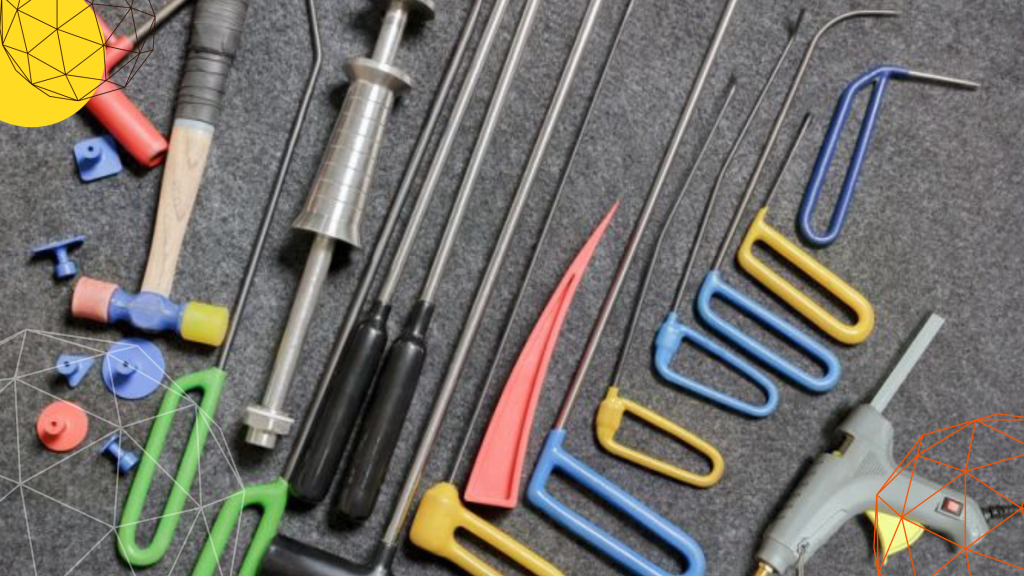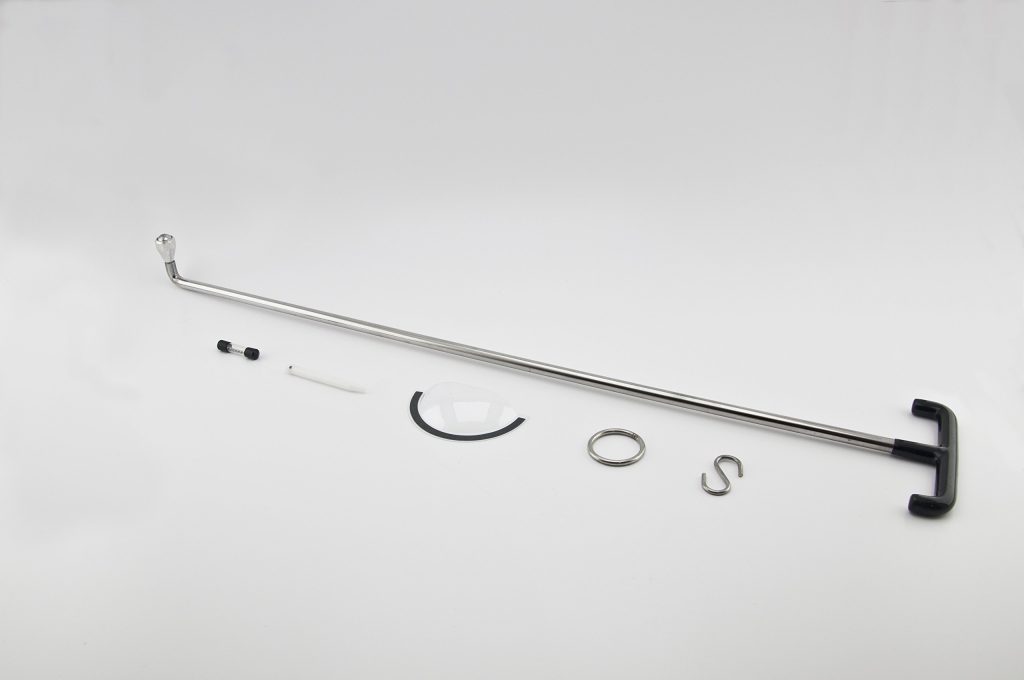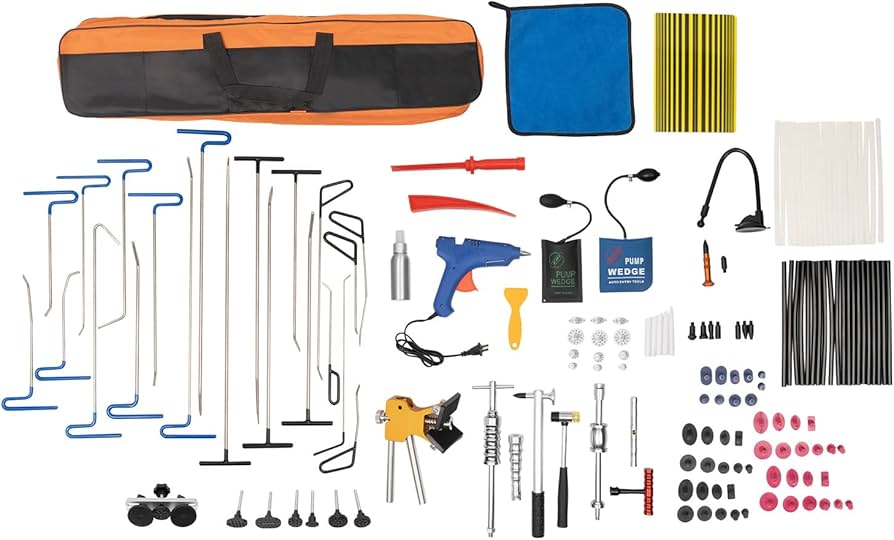
You don’t have to stare too long at those unsightly dings on your auto and worry about the hefty cost of repairing them. You can remove the pesky dents forever using paintless dent tools, or PDR.
This innovative solution provides a simple and economical technique to handle the blemishes of your car without repainting. So, there’s no need to hassle your wallet and yourself with the traditional ways.
Want to learn more about this revolutionary auto repair technology? Continue reading.]
Table of Contents
What are PDR Tools
PDR stands for Paintless Dent Removal, a skilful technique to remove dents and dings from your car without needing to repaint or go through the typical heavy bodywork.
There are two categories of PDR tools: power tools and hand tools.
Power tools are used to handle bigger dents that require a considerable amount of force, while hand tools are leveraged for minor dents that can be dealt with with manual force.
So, how do PDR tools remove dents without damaging the vehicle’s paint?
It works by lifting or pulling the dent out from the panel of your vehicle with the help of specialised tools. This technique will put the metal back together in its original shape, avoiding the steep price of bodywork and repainting.
Scenarios where Paintless Dent tools are Used
Paintless dent repair is a versatile solution to promptly address the dents and dings of your car.
Here are the typical situations where PDR tools can shed some light:
Accidental Hits
One of the common reasons for car dents is accidental hits from shopping carts while doing groceries or from other vehicles while you’re parking in tight spaces.
PDR tools come in handy to gently massage the dents and even out the surface of the affected area.
Hailstones
When the hailstones rain down on your car’s surface, it can create creases and dents.
But don’t worry; PDR tools are proficient in taking care of these little imperfections, allowing complete restoration for your panels—minus repainting.
Road Debris
When you’re driving on rough roads while camping with friends, loose stones and debris start flying and knocking your car’s body panels.
PDR tools are the most adept at rectifying the small dents on your vehicle’s surface and ensuring a smooth finish.
Door Problems
When you’re hurrying to get in and out of the car, you are prone to bumping the door on fixtures or other vehicles nearby. This creates trivial but obvious dents that PDR tools can easily fix, leaving no trace of imperfections on the surface.
Minor Collisions
Low-speed collisions can distort the panels of your auto. But don’t go running to a car repair shop just yet; you can utilise PDR tools to reform and smooth out the dents.
Evolution of Dent Repair Tools
Before PDR tools, dent repair used to be scary. It’s not only labour-intensive but also expensive. Traditional methods require repainting, which takes forever, costing you an arm and a leg.
Fortunately, technology paved the way for modern tools, kicking off with paintless dent removal tools. And the guy who prompted this idea was Frank T. Sargent in 1931.
Twenty years later, Oskar Flaig introduced PDR tools at a popular auto exhibition in New York. He was a paintworker who used dent cars in his show, and to save time he would use a hammer to pull the dent out of the panel.
From then on, PDR has evolved and expanded to what it is today—passing from one master technician to another. Rods and tapping devices debuted in the 1980s; the glue-pulling tools came thereafter in the 90s, and PDR lights in the 2000s.
These technological advancements pushed dent repair work further. It made it more effective and efficient while keeping the original paint intact. Simply put, PDR tools have revolutionised how we handle dent issues.
Types of Car Paintless Dent Removal Tools
Dent Rods and PDR Bars

These essential tools come in different shapes and sizes to tackle a variety of dents. They are designed to manipulate and push dings out from behind the panel. They can restore the original form of your car without marring the paint finish.
Glue Pulling Kits
Glue-pulling tools work by gluing the exteriour panel of your car with custom hot glue. Once the glue cools down, it provides a firm bond, allowing you to pull the dent out.
This method is more straightforward and highly efficient than traditional repairs because it removes repainting out of the picture.
Slide Hammers and T-Pullers
Slide hammers are attached to the small dent of your car, and in a sliding motion, you lift the dent out.
Meanwhile, T-pullers are the tools used for more extensive dent repairs. The T shape allows for easy operation, giving the grip and leverage to pull the dent out without upsetting the original paint.
Just be careful when using these tools, because they produce significant force that can damage your paint without proper technique.
Tap Down Tools and Hammers
These are essential PDR tools for fine-tuning and finishing. They come in different sizes and forms to cover different spots and allow the right amount of pressure.
They are used to accurately manipulate the dent, refining imperfections without affecting the paint after the dent has been lifted.
Light Boards and Reflectors
Light boards and reflectors are leveraged to identify and evaluate the dent during repair. This is particularly helpful to determine the size, shape and location of the dents that are too subtle for the naked eye.
These lights can be hand-held or mounted with varying levels of brightness for more precise work.
Right Tools You Need in Your PDR Kit

Heads up, beginners and professionals—if you want to navigate your car dent issues with confidence, here are the essential tools that you need to gather:
• PDR Rods
• PDR Picks
• Glue Pulling Kit
• Tapping tools
• PDR lights
• Knives and scrapers
Now, for the criteria in selecting your high-quality PDR tools, take heed of the following:
Durability
Choose tools that can endure frequent use and are wear-resistant.
Materials
High-quality tools are made of superiour materials like stainless steel or carbon fibre. They ensure reliable performance and longevity even in challenging conditions.
Ease of Use
Opt for tools that are designed ergonomically. They have a comfortable grip that allows better control and precise repairs. Even after prolonged use, you’d barely experience hand fatigue.
Recommended Brands and Kits Available in the Market
Now that you know what factors to weigh in when choosing your PDR dent tool, let’s check out the best brands available in the market today.
• HDPRO Tabs
• Dent craft
• Metal Medic Power Green PDR Glue
• BIGFOOT Porta-Power BOOT KIT
• Anson PDR
• GlasWeld
• XKTools
Advantages of PDR Tools
PDR tools are heaven-sent from the gods of auto care. Imagine you’re provided with an innovative solution to fix various dents in your car that’s easy to use, effective and so gentle with your wallet.
Cost-Efficiency
Traditional methods typically involve a long list of time-consuming, not to mention resource-heavy and labour-intensive, processes that will surely hurt your wallet.
Conversely, PDR is less laborious and less heavy on materials. By eliminating the need for costly repainting and labor, you’re cutting the overall costs significantly.
Time-Saving
Time-saving is another attractive benefit of PDR. You see, traditional dent repair takes days, even weeks, to complete, depending on the magnitude of the damage and the repair shop’s workload.
On the other hand, PDR only takes hours to finish. The reason for the quick turnaround time is that PDR skips auto repair processes like repainting and curing times.
With no paint and fillers involved, you have a faster repair process on your hands and a speedier return to your usual routine.
Eco-Friendly
Paintless dent repair tools protect your car’s structure and value while retaining the original paint.
It’s a sustainable option for green-thumbed car owners because it eliminates the several steps in traditional methods, which are chemical and material-heavy. As a result, it reduces the waste and chemicals used.
Preserving Original Paintwork
PDR can maintain your car’s value and aesthetics.
You see, the authentic coating of your vehicle is so much better than the repaint. It has a far superiour quality, which provides stronger protection against damaging environmental factors.
Conclusion
As you can see, there’s a way out of those dents and dings of your car without the extensive labour and scary costs. Paintless dent removal tools have revolutionised the way we deal with auto repairs.
Professional or not, with the right tools and proper technique, you can fix larger imperfections without repainting.
Dare we say, invest in top-notch PDR tools to be more efficient in handling every dent you encounter and achieve optimal results.
FAQs About Paintless Dent Repair Tools
What types of dents can PDR tools fix?
PDR is perfect for superficial dents that don’t require repainting. These are minor dings induced by shopping carts, hailstones, road debris and small collisions.
Are PDR tools difficult to use for beginners?
It can be challenging for beginners to use PDR tools without skills and practise. Anyhow, it can be done, start by working on minor dents to gain some experience. As you learn and hone your skills, you can refine your technique.
You can also watch tutorial videos or read blog posts to gain more knowledge and enhance your efficiency.
But if you’re working on bigger and more complex dents, it’s always best to seek the help of experts.
How do I maintain my PDR tools?
You have to thoroughly clean your tools after you use them with a soft cloth and a mild solution to remove any lingering dirt.
Afterwards, store them in an organised, dry space and regularly inspect them. This way, you can spot any signs of wear and ensure they’re in great condition.
Can PDR tools be used on all types of vehicles?
Yes, you can use PDR tools on all types of automobiles, like motorcycles or trucks. They’re specifically manufactured to suit various panel sizes and shapes.
Do I need training to use PDR tools effectively?
Yes, you do. We highly recommend training to learn the basic techniques necessary to ensure the best results.
Using PDR tools without proper knowledge can damage your vehicle’s paint—and you don’t want to risk that.
